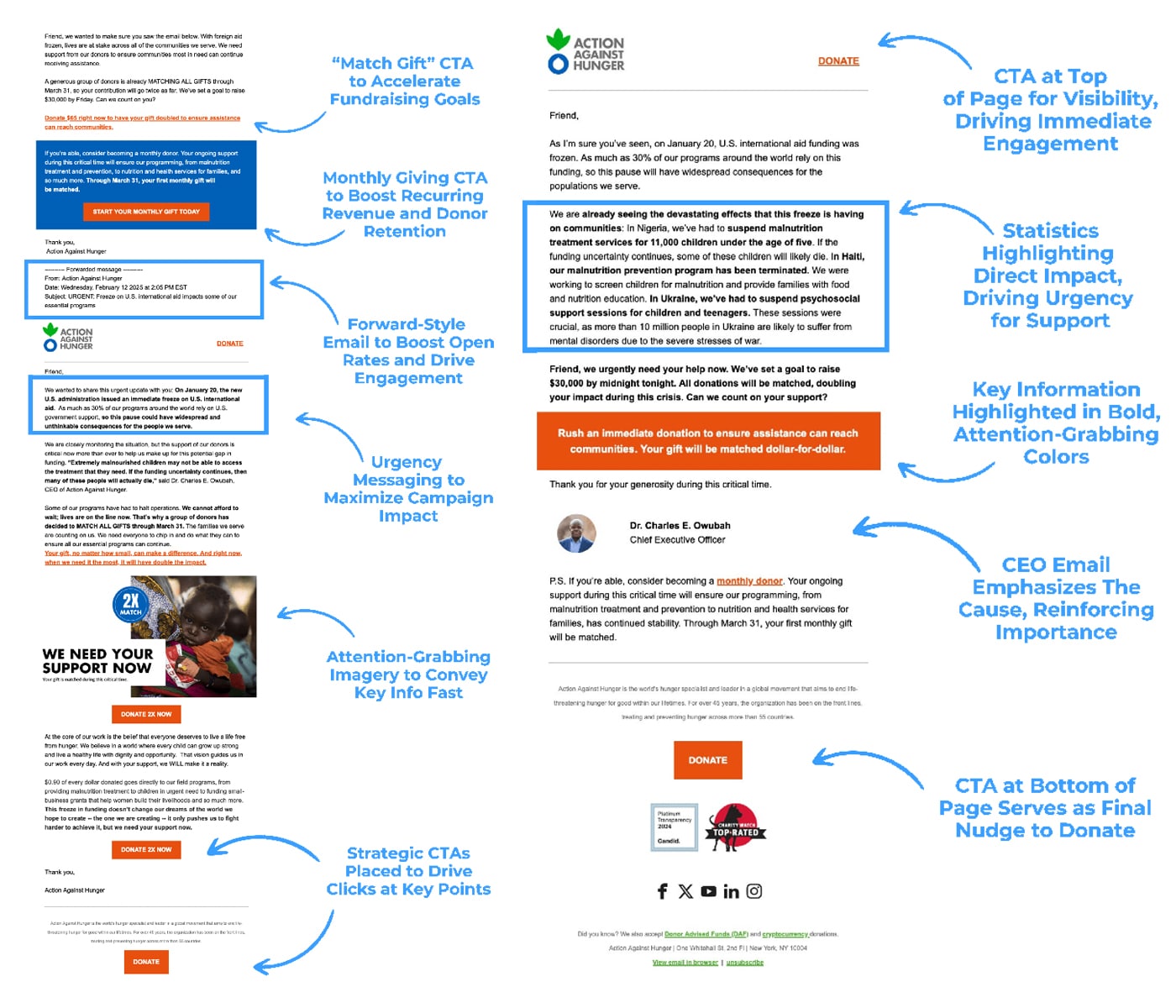The Case for Rapid Response Optimization
When a funding freeze hits or a major grant falls through, nonprofit leaders don’t have the luxury of waiting it out. They’re expected to do more with less, inspire urgency without panic, and somehow turn volatility into opportunity. Sound familiar?
In these moments, the pressure is immense and the stakes are high. But here’s the truth: nonprofits are businesses. And just like any for-profit facing an economic downturn, success depends on agility, insight, and the ability to optimize in real time.
Uncertainty Doesn’t Discriminate Between Sectors
Back in 2008, major brands couldn’t wait for the dust to settle, they shifted, tested, and adapted. The same applies today for mission-driven organizations. The stakes might look different (you’re not selling sneakers, you’re saving lives or protecting ecosystems), but the operational mindset? It should be just as sharp.
Take Action Against Hunger: when a USAID freeze threatened roughly 30 % of annual revenue this February, a three-email “Federal Funding Freeze” appeal landed a 91.98% increase over average donations, and matched-gift CTAs kept donations climbing. UNICEF showed the same playbook at scale, raising $1.165 million in just nine days for children in Yemen by A/B-testing Facebook creative during the 2018 crisis.

Their success wasn’t luck. It was speed and optimization.
Urgency and Strategy Can (and Should) Coexist
We’ve seen it so many times: a global headline hits, a funding opportunity evaporates, or a crisis erupts and the response is pure adrenaline. “Get the email out.” “Push the banner live.” “Post something now.”
Totally understandable. But it can also be a missed opportunity.
Crisis moments are also high-traffic moments. Which means you can learn fast, iterate faster, and convert more effectively.
One of our largest nonprofit clients saw a 30%+ lift in donations during a high-pressure campaign window, not because they moved first but because they moved smart. We tested four banner headlines, two subject line angles, and launched a rapid email workflow to build connection with new donors the moment they clicked “donate.”
Because the real win isn’t just a one-time gift. It’s turning a “crisis donor” into a “your-mission-is-my-mission” kind of donor.
Cross-Channel Clarity
In the middle of an urgent fundraising push, it’s easy for messaging to go out fast…and get a little fragmented. But your donors are moving across email, social, SMS, and your website seamlessly, so your message needs to move with them.
Consistency means creating a clear, compelling throughline that builds trust no matter where someone encounters your campaign.
Ask yourself:
- Does the message in your email also show up (in spirit and tone) in your Instagram captions?
- Does the homepage banner support what you just asked in a text message?
- Do your donation pages carry the same urgency—and humanity—as the paid ad that got them there?
We helped one nonprofit revamp their entire emergency campaign flow from homepage banners to post-donation follow-ups. The result? A 2.4x increase in conversions and a 20% uptick in donor retention post-campaign because their message was clear, coordinated, and continuously optimized.

Building the Right Support System Starts with the Right Questions
During high-stakes moments, having the right support makes all the difference. Whether you’re working with an internal team, an external agency, or a mix of both, here are a few helpful questions to guide alignment:
- Are we exploring, strategizing and testing different message angles—or defaulting to what feels most urgent?
- Do we have workflows ready to welcome and build rapport with new donors after a major campaign?
- Are we tailoring communications based on donor behavior, giving tier, or past engagement?
- Are we learning in real time and optimizing as we go?
You don’t have to have every answer. But your internal leaders and external advisors, like your digital campaigner, VP of Membership, or email fundraising agency, should proactively bring these questions to you and help map out the solutions.
The best teams anticipate, strategize, and optimize to unlock growth when it matters most.
Nonprofit Fundraising Deserves the Same Strategic Muscle
Customer journey mapping. Conversion rate optimization. Segmentation and Optimization. These are table stakes in for-profit marketing. In the nonprofit space, these same tools are sometimes seen as “nice to have” or advanced strategies but they’re anything but optional when donor dollars are on the line.
Every donor, whether they give $5 or $50,000, can feel seen, understood, and part of something bigger. That does require more than just good messaging. It takes intentional strategy, consistent iteration, and a willingness to adapt in real time.
The good news? It’s completely doable.
We’ve helped mission-driven teams raise over $75 million in low-dollar gifts, using the same proven techniques that power top-tier eCommerce and growth organizations. From leading Sierra Club’s full-stack digital marketing to expanding Oceana’s international reach, our team brings experience and deep respect for the work you do and the supporters who make it possible.
What You Can Do Today
Here’s how to start building momentum, even with limited time or resources:
- Take a look at your donor experience. Where can you improve clarity, reduce friction, or introduce testing to learn faster?
- Prep your rapid response toolkit. If something urgent landed tomorrow, do you have a campaign plan and workflows ready to go?
- Check in with your agency partner. Are they bringing proactive insights? Are they helping you grow smarter, not just work harder?
No need to overhaul everything overnight. But if you’re ready to strengthen your strategy and build resilience into your fundraising, we’d love to help.

